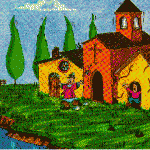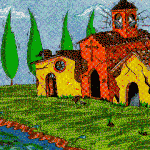The Modified Mercalli Intensity (MMI) scale depicts shaking severity. An earthquake has a single magnitude that indicates the overall size and energy released by the earthquake. However, the amount of shaking experienced at different locations varies based on not only that overall magnitude, how far you are from the fault that ruptured in the earthquake, and whether you are on rock or thick valley deposits that shake longer and harder than rock.
While newer buildings in the Bay Area are designed to withstand this shaking component without killing people, the buildings can still be heavily damaged and may not be able to be used for days, weeks, or even months after the earthquake. The descriptions of the various MMI categories that follow focus on damage to older unreinforced masonry buildings, chimneys, and wood-frame homes.
- For additional information on the percentages of residential units that have statistically been made uninhabitable in past California earthquakes by construction type and MMI level, click here.
- For information on how to make your home safer, click here.
- View the plain text version.
- The colors on this table correspond to the colors in the shaking scenario maps.
| MMI value | Summary description used on maps | Description of shaking severity | Full description shortened from Elementary Seismology | |
|---|---|---|---|---|
 |
I | Not mapped | Not mapped | Not felt. |
 |
II | Not mapped | Not mapped | Felt by people sitting or on upper floors of buildings. |
 |
III | Not mapped | Not mapped | Felt by almost all indoors. Hanging objects swing. Vibration like passing of light trucks. May not be recognized as an earthquake. |
 |
IV | Not mapped | Not mapped | Vibration felt like passing of heavy trucks. Stopped cars rock. Hanging objects swing. Windows, dishes, doors rattle. Glasses clink. In the upper range of IV, wooden walls and frames creak. |
 |
V | Light | Pictures move | Felt outdoors. Sleepers wakened. Liquids disturbed, some spilled. Small unstable objects displaced or upset. Doors swing. Pictures move. Pendulum clocks stop. |
 |
VI | Moderate | Objects fall | Felt by all. People walk unsteadily. Many frightened. Windows crack. Dishes, glassware, knickknacks, and books fall off shelves. Pictures off walls. Furniture moved or overturned. Weak plaster, adobe buildings, and some poorly built masonry buildings cracked. Trees and bushes shake visibly. |
 |
VII | Strong | Nonstructural damage | Difficult to stand or walk. Noticed by drivers of cars. Furniture broken. Damage to poorly built masonry buildings. Weak chimneys broken at roof line. Fall of plaster, loose bricks, stones, tiles, cornices, unbraced parapets and porches. Some cracks in better masonry buildings. Waves on ponds. |
 |
VIII | Very strong | Moderate damage | Steering of cars affected. Extensive damage to unreinforced masonry buildings, including partial collapse. Fall of some masonry walls. Twisting, falling of chimneys and monuments. Wood-frame houses moved on foundations if not bolted; loose partition walls thrown out. Tree branches broken. |
 |
IX | Violent | Heavy damage | General panic. Damage to masonry buildings ranges from collapse to serious damage unless modern design. Wood-frame structures rack, and, if not bolted, shifted off foundations. Underground pipes broken. |
 |
X | Very violent | Extreme damage | Poorly built structures destroyed with their foundations. Even some well-built wooden structures and bridges heavily damaged and needing replacement. Water thrown on banks of canals, rivers, lakes, etc. |
 |
XI | Not mapped because these intensities are typically limited to areas with ground failure. | Rails bent greatly. Underground pipelines completely out of service. | |
 |
XII | Not mapped because these intensities are typically limited to areas with ground failure. | Damage nearly total. Large rock masses displaced. Lines of sight and level distorted. Objects thrown into the air. | |
Full descriptions are shortened from: Richter, C.F., 1958. Elementary Seismology. W.H. Freeman and Company, San Francisco, pp. 135-149; 650-653. To view these descriptions, see the On Shaky Ground report.
Artwork is courtesy of the Campagna Mulitmediale di Informazione of the Osservatorio Geofisico Sperimentale in Italy (Italia). Molto gracie.

